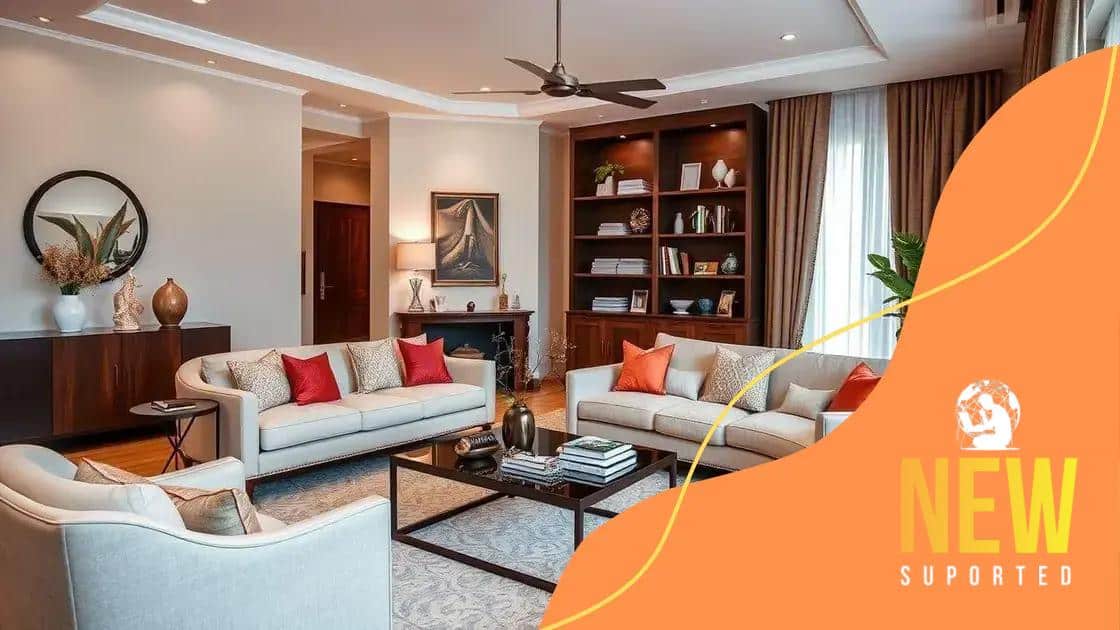How to mix modern and traditional decoration styles

Mixing modern and traditional decoration styles involves blending clean lines and elaborate details while maintaining a cohesive color palette and thoughtful accessorizing to create a harmonious and inviting space.
Have you ever wondered how to mix modern and traditional decoration styles? Combining these two aesthetics can create a unique and inviting atmosphere in your home. Let’s explore some ideas that can help you achieve the perfect blend.
Understanding modern decoration principles
When we talk about modern decoration principles, it’s essential to understand their core concepts. Modern design is all about simplicity, clean lines, and functionality. The focus is to create a space that feels open, airy, and uncluttered.
One prominent aspect is the use of neutral colors. White, gray, and beige are commonly used as base colors. These shades help create a calm atmosphere. Bright accents, such as a colorful artwork or a vibrant sofa, can bring life to a modern space.
Key Elements of Modern Design
In modern decoration, specific elements stand out:
- Minimalism: Less is more in modern decor. Clutter-free spaces allow for easier movement and visual clarity.
- Natural Light: Large windows and open spaces maximize light. This aspect contributes to a fresh and welcoming vibe.
- Functional Furniture: Every piece should have a purpose. Look for furniture that is sleek yet practical.
- Textural Contrast: Mixing materials like metal, glass, and wood creates depth and interest.
Another vital point is the furniture selection. Furniture in modern design typically has clean lines and geometric shapes. Think low-profile sofas and sleek coffee tables. These pieces complement the open feel of the space while adding a touch of style. Moreover, using large-scale art can enhance a minimalist space, providing character without overwhelming it.
Importance of Space
Understanding how to use space effectively is crucial. In modern decor, achieving a balance between empty areas and filled spaces allows the room to breathe. Too much furniture can make a space feel cramped.
Incorporating some plants can soften harsh lines and add warmth. A simple green plant on a side table can make a great statement. Each element in a modern design should interact harmoniously with others, creating an inviting and functional atmosphere.
Key features of traditional decor
Exploring the key features of traditional decor helps us appreciate the charm and elegance of classic design. Traditional decor is rooted in heritage and history, showcasing rich aesthetics and craftsmanship.
One of the first things you’ll notice is the use of rich colors. Unlike modern designs that favor neutrals, traditional spaces often feature deep tones like burgundy, navy, and forest green. These colors evoke a sense of warmth and comfort, enhancing the inviting nature of traditional settings.
Common Elements
Traditional decor is characterized by specific elements that are consistently present:
- Ornate Details: Traditional designs emphasize elaborate patterns and textures, often seen in wallpaper, fabrics, and decorative moldings.
- Classic Furniture: Pieces like wingback chairs, wooden dining tables, and armoires are commonly used. They typically feature intricate carvings and rich upholstery.
- Symmetry: Balance is crucial in traditional spaces. Furniture is often arranged in symmetrical layouts to create harmony.
- Decorative Accessories: Items like chandeliers, mirror frames, and framed artwork add a classic touch that personalizes the space.
Another aspect of traditional decor is the natural materials used in construction and furnishing. Wood, stone, and metals are predominant, often crafted by skilled artisans. This connection to nature adds character and history to each piece.
Textiles and Patterns
Textiles play a significant role as well. Heavy drapes, plush rugs, and embroidered pillows enhance comfort while adding layers of style. Patterns such as damask or toile are commonly used, providing depth to surfaces and furniture.
In traditional decor, layering is essential. Combining various textures and colors creates a rich visual experience. An area rug can anchor the space, while patterned pillows on a neutral sofa can tie the design together seamlessly.
Balancing colors and textures

Balancing colors and textures in your home design is crucial for creating a cohesive and inviting atmosphere. A well-thought-out palette can transform any space, making it more appealing and comfortable. Understanding how to combine different hues and surfaces allows you to elevate your decor.
Color is one of the most powerful tools in decoration. It can set the mood, create harmony, or add energy to a room. When choosing a color scheme, consider starting with a neutral base like white or gray. These colors provide a fresh backdrop and allow you to add pops of color through accessories.
Choosing Your Color Palette
Here are some tips for selecting colors that work well together:
- Analogous Colors: These colors are next to each other on the color wheel, like blue and green. They create a serene and comfortable look.
- Complementary Colors: Colors opposite on the wheel, such as blue and orange, create a striking visual contrast that can energize your space.
- Monochromatic Scheme: Using variations of a single color can add depth while maintaining a cohesive look.
- Accent Colors: Introduce small amounts of bright colors through decor items, artwork, or cushions to create focal points without overwhelming the space.
Texture is another essential element that can add interest to your design. Mixing textures like soft fabrics, glossy surfaces, and rough materials can create a dynamic and inviting environment. A plush rug under a sleek coffee table can combine comfort and modern elegance.
Layering Textures
When layering textures, consider these points:
- Variations: Use different textures in each layer to create depth. Combine smooth leather with soft cotton for a balanced feel.
- Contrast: Pairing hard and soft textures can enhance visual interest. For example, pair a glass lamp with a chunky knitted throw.
- Natural Elements: Incorporate natural materials like wood or stone. They bring warmth and a sense of organic beauty to the decor.
Finding the right balance of colors and textures can greatly enhance your home’s overall aesthetic. Experimenting and trusting your instincts can lead you to discover surprising combinations that work beautifully together.
Incorporating furniture styles
Incorporating different furniture styles into your home can create a unique and dynamic space. Mixing modern and traditional pieces not only adds visual interest but also reflects your personal taste. Understanding how to blend styles can enhance your decor and make it truly your own.
When combining furniture styles, start by identifying key elements of each design. Modern furniture typically has clean lines, minimalistic forms, and functional features. Traditional furniture, on the other hand, often showcases intricate details, rich woods, and classic shapes. Finding a balance between these two can lead to beautiful results.
Mixing Styles Effectively
Here are some tips to keep in mind when incorporating furniture styles:
- Maintain a Common Palette: Use a cohesive color scheme to tie different styles together. For example, a warm neutral base can work with both traditional wood tones and modern upholstery.
- Focus on Scale: Ensure that the sizes of your furniture pieces complement each other. A large traditional dining table can be paired with modern chairs, creating a balanced look.
- Create Focal Points: Choose one style to dominate a room while allowing the other to accentuate it. For instance, a modern sofa can stand out against traditional wallpaper.
- Accessorize Thoughtfully: Use accessories to bridge the gap between styles. A contemporary coffee table with traditional decor items can create harmony.
Another effective way to incorporate different styles is through layering. Adding a traditional rug on top of modern flooring can create depth. Similarly, placing modern art on traditional furniture juxtaposes styles in an intriguing way.
Combining Materials
Don’t forget that materials play a significant role in the overall feel. Different textures can enrich your design. Pairing sleek metals with warm woods can create a balanced atmosphere. For example, a metal lamp can add a contemporary touch to a wooden desk.
Ultimately, the goal is to create a space that feels cohesive despite the style differences. Trust your instincts and choose pieces that resonate with you. This mixture of styles will make your home feel inviting and uniquely yours.
Creating cohesive spaces
Creating cohesive spaces is essential for a harmonious home environment. A cohesive space feels unified and comfortable, allowing the various elements within it to work together beautifully. By focusing on design principles, you can achieve a balanced look that reflects your personal style.
First, consider the color scheme. Consistent use of colors helps tie different areas together. Start with a base color that you love, then choose complementary shades for accents. This approach creates a natural flow throughout your home, linking rooms effectively.
Using Patterns and Textures
Another key aspect is the use of patterns and textures. Mixing different patterns can be challenging, but it can also be rewarding. To ensure harmony:
- Limit the Number of Patterns: Stick to two or three main patterns that can be repeated in various areas.
- Vary Scale: Use large patterns in some spaces and smaller ones in others. This variation prevents the design from feeling chaotic.
- Incorporate Textures: Layer textures like soft fabrics, smooth metals, and natural woods to create depth and interest.
Additionally, consider the furniture arrangement. Open layouts can help connect spaces visually, while careful placement can define different areas within a larger room. Group furniture to create cozy conversation areas while maintaining clear pathways for movement.
Thoughtful Accessories
Accessorizing thoughtfully is crucial for establishing cohesion. Use decorative items that resonate with your chosen color palette. For instance, consider art pieces, vases, and textiles that feature similar tones or themes. This strategy emphasizes unity and makes each item feel intentional.
Lighting also plays a vital role in creating cohesive spaces. Choose fixtures that align with your overall theme. For example, a modern pendant light can complement contemporary decor, while a classic chandelier might suit a more traditional setting. Layering different light sources—ambient, task, and accent—can help establish a well-lit, inviting atmosphere throughout your home.
FAQ – Questions about Mixing Modern and Traditional Decoration Styles
How can I start mixing modern and traditional furniture styles?
Begin by selecting a cohesive color palette that works for both styles, then gradually incorporate pieces that resonate with your decor.
What are some key elements to consider when creating cohesive spaces?
Consider using a consistent color scheme, mixing patterns and textures wisely, and arranging furniture to promote clear pathways.
How do I choose the right accessories for my mixed decor?
Select accessories that complement your chosen color palette and reflect both styles, enhancing the overall harmony of your space.
Can I combine bold colors with neutral tones?
Absolutely! Using bold colors as accents against a neutral backdrop can create stunning focal points and balance in your decor.






